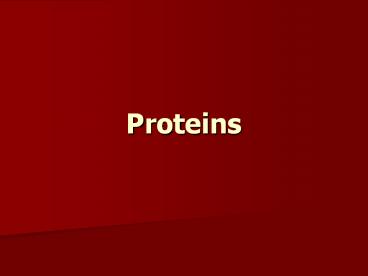Proteins - PowerPoint PPT Presentation
Title: Proteins
1
Proteins
2
- The word protein is derived from the Greek word
proteios. Which means primary or of prime
importance. - Proteins are composed of long chains of amino
acids joined together via peptide bonds. - A polypeptide with more than 100 amino acid
residues, having molecular mass more than 10,000u
is called a protein.
3
Amino Acids
Amino acids are derivatives of carboxylic acids
formed by substitution of ?-hydrogen for amino
functional group.
4
- AA are optically active molecules due to the
presence of a chiral carbon (except in the case
of glycine where the R-group is hydrogen)
According new IUPAC nomenclature L- D- forms were
replaced for (S)- and (R)- system
5
Proteins play key roles in a living system
- Three examples of protein functions
- CatalysisAlmost all chemical reactions in a
living cell are catalyzed by protein enzymes. - TransportSome proteins transports various
substances, such as oxygen, ions, and so on. - Information transferFor example, hormones.
- Structural proteins proteins with the primary
purpose of producing the essential structural
components of the cell.
Alcohol dehydrogenase oxidizes alcohols to
aldehydes or ketones
Haemoglobin carries oxygen
Insulin controls the amount of sugar in the blood
6
Amino acid Basic unit of protein
Different side chains, R, determin the properties
of 20 amino acids.
7
Zwitter Ion
A zwitter ion is a chemical compound that carries
a total net charge of 0 and is thus electrically
neutral, but carries formal charges on different
atoms.
8
20 Amino acids
Leucine (L)
Isoleucine (I)
Glycine (G)
Valine (V)
Alanine (A)
Methionine (M)
Asparagine (N)
Tryptophan (W)
Phenylalanine (F)
Proline (P)
Tyrosine (Y)
Threonine (T)
Serine (S)
Glutamine (Q)
Cysteine (C)
Histidine (H)
Glutamic acid (E)
Asparatic acid (D)
Lysine (K)
Arginine (R)
White Hydrophobic, Green Hydrophilic, Red
Acidic, Blue Basic
9
Proteins are linear polymers of amino acids
R2
R1
COO?
COO?
NH3
NH3
C
C
H
H
A carboxylic acid condenses with an amino group
with the release of a water
H2O
H2O
R1
R2
R3
C
CO
C
CO
NH3
NH
NH
C
CO
Peptide bond
Peptide bond
H
H
H
The amino acid sequence is called as primary
structure
D
F
T
A
A
S
K
G
N
S
G
10
Classification of Proteins
11
Globular Proteins
- Proteins that consist of long chains of amino
acids folded up into complex shapes. Globular
proteins serve as, or form important components
of, the following - Enzymes
- Hormones
- Antibodies
- Some structural proteins.
12
Structure of Insulin
13
Fibrous Proteins
- Proteins that tend to be insoluble and strong and
so play a structural role in organisms for
support or protection. They can be subdivided
into several different types - keratins, found in hair, fingernails, and bird
feathers - collagens the most abundant proteins in a
vertebrate body found in connective tissues
such as cartilage - elastins, found in ligaments, around blood
vessels.
14
Structure of Keratin
15
DIFFERENCES BETWEEN GLOBULAR AND FIBROUS PROTEINS
Globular
Fibrous
- They have polypeptide chains which lie side by
side, held together by H-bonds and have thread
like structure. - Fibrous proteins are insoluble in water.
- They are more or less spherical in
- shape.
- Globular proteins are usually soluble in water.
Eg insulin, albumins, etc.
Eg keratin, myosin, etc.
16
Structure of Proteins
17
Each Protein has a unique structure
Amino acid sequence NLKTEWPELVGKSVEEAKKVILQDKPEAQI
IVLPVGTIVTMEYRIDRVRLFVDKLDNIAEVPRVG
Folding!
18
Basic Structural Units of Proteins
19
Primary Structure
The sequence in which the amino acids are
arranged in a polypeptide chain of a protein is
called the primary structure of the protein.
20
Secondary structure
- There are two types of structural proteins
- a-helix
- The peptide chain coils and the turns of the
coil are held together by hydrogen bonds. - ß-pleated sheet
- Here the protein chains are not coiled but are
stretched out.
21
a-helix
ß-sheet
Secondary structures, a-helix and ß-sheet, have
regular hydrogen-bonding patterns.
22
(No Transcript)
23
Tertiary Structure
Arises due to folding and coiling of secondary
proteins.
- Quaternary Structure
Composed of two or more polypeptide chains.
24
(No Transcript)
25
Three-dimensional structure of proteins
Tertiary structure
Quaternary structure
26
Hierarchical nature of protein structure
- Primary structure (Amino acid sequence)
- ?
- Secondary structure (a-helix, ß-sheet)
- ?
- Tertiary structure (Three-dimensional structure
formed by assembly of secondary structures) - ?
- Quaternary structure (Structure formed by more
than one polypeptide chains)
27
Close relationship between protein structure and
its function
Hormone receptor
Antibody
Example of enzyme reaction
substrates
A
enzyme
enzyme
B
Matching the shape to A
Digestion of A!
enzyme
A
Binding to A
28
Protein structure prediction has remained elusive
over half a century
- Can we predict a protein structure from its
amino acid sequence? - Now, impossible!
29
Native State
At normal pH and temperature, each protein will
take up a shape which is energetically most
stable. This shape is called the native state of
a protein.
30
Protein denaturation
- Denatured state unfolded state
- Native state folded state
- Denaturation heat, urea, salts
31
Summary
- Proteins are key players in our living systems.
- Proteins are polymers consisting of 20 kinds of
amino acids. - Each protein folds into a unique
three-dimensional structure defined by its amino
acid sequence. - Protein structure has a hierarchical nature.
- Protein structure is closely related to its
function. - Protein structure prediction is a grand challenge
of computational biology.
32
Thank You For Your Attention

